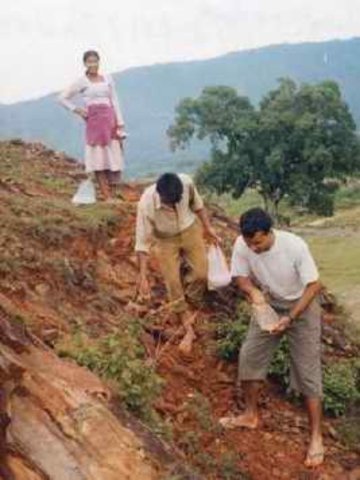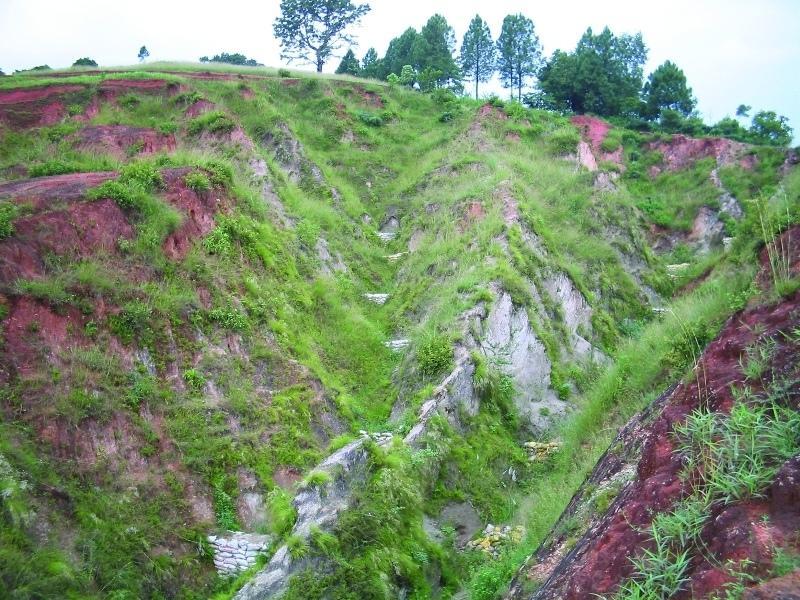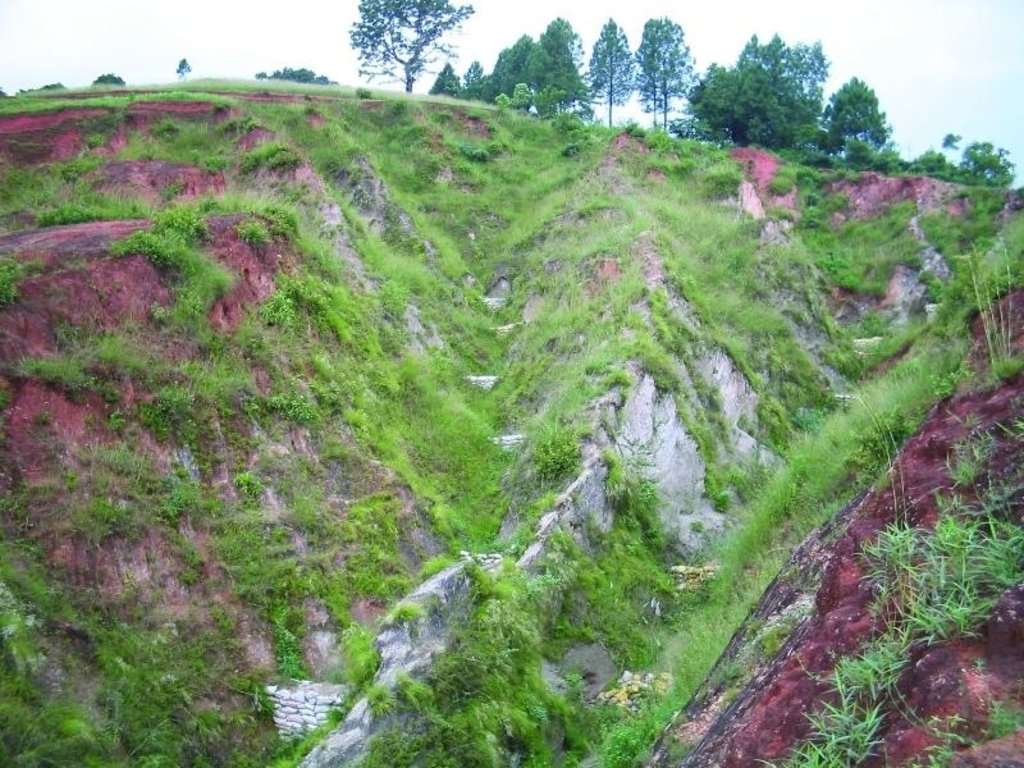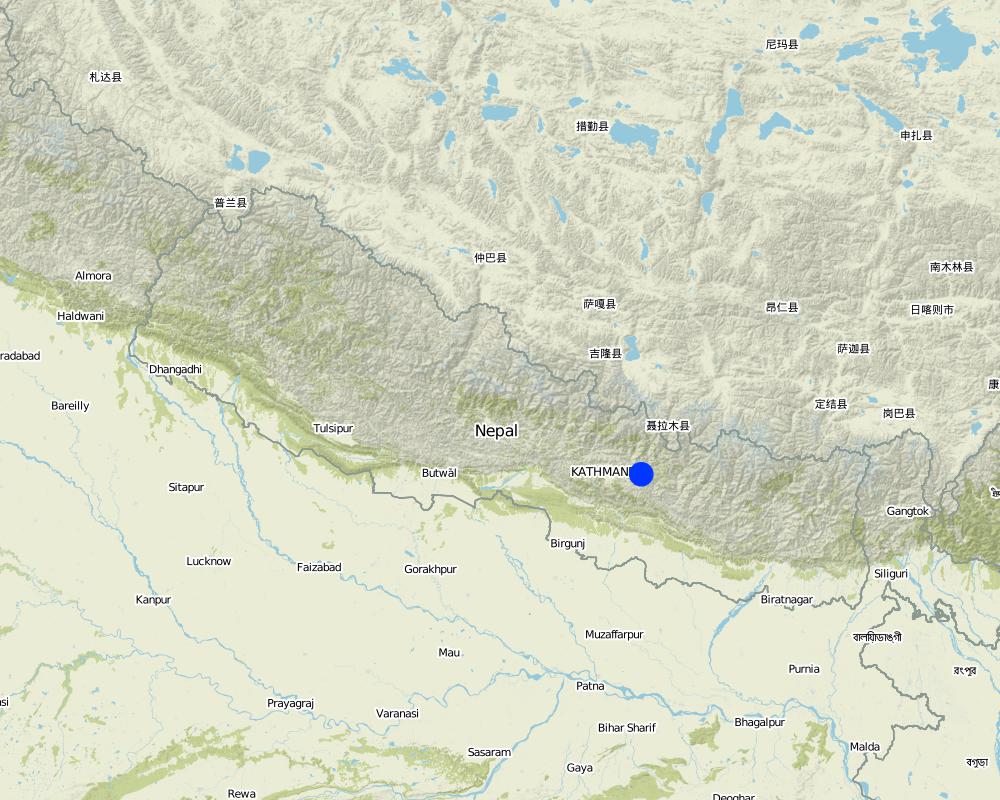Gully plugging using check dams [尼泊尔]
- 创建:
- 更新:
- 编制者: Nicole Guedel
- 编辑者: –
- 审查者: David Streiff, Alexandra Gavilano
Galchhi niyantran - Nepali
technologies_1493 - 尼泊尔
查看章节
全部展开 全部收起1. 一般信息
1.2 参与该技术评估和文件编制的资源人员和机构的联系方式
SLM专业人员:
SLM专业人员:
有助于对技术进行记录/评估的项目名称(如相关)
People and Resource Dynamics Project, Nepal (PARDYP)有助于对技术进行记录/评估的机构名称(如相关)
ICIMOD International Centre for Integrated Mountain Development (ICIMOD) - 尼泊尔1.3 关于使用通过WOCAT记录的数据的条件
编制者和关键资源人员接受有关使用通过WOCAT记录数据的条件。:
是
1.5 参考关于SLM方法(使用WOCAT记录的SLM方法)的调查问卷

Local initiatives for rehabilitating degraded communal grazing land [尼泊尔]
Supporting local initiatives and building local capacity for the rehabilitation of degraded communal land in the middle mountains of Nepal.
- 编制者: Madhav Dhakal
2. SLM技术的说明
2.1 技术简介
技术定义:
Small dam structures constructed across erosion gullies
2.2 技术的详细说明
说明:
Check dams are small low structures built across a gully or a channel to prevent them from deepening further. These small dams reduce the speed of water flow and minimise the erosive power of runoff. They also promote the deposition of eroded materials to further stabilise the gullies.
Two gullies adjacent to a degraded area of communal grazing land were controlled by constructing check dams and with vegetative measures including planting bamboo. The main purpose was to control the further development of the gullies, which were affecting the adjacent grazing land and blocking a downstream irrigation channel. The site is community land used by the 40 households (240 people) of Dhotra village in the intensively used Jhikhu Khola watershed. Irrigated cropland lies downstream from the site, whilst the site itself is bordered by grazing land, degraded sal-dominated forest, and rainfed forward-sloping terraces.
The check dams were made of old cement bags filed with soil and were 1m high with 0.5m deep foundations. The check dams were spaced so that a line joining the top of two adjacent dams had about a 3% slope gradient. Twenty-four check dams were built in the two gullies using a total of 2400 filled cement bags. Forty clumps of bamboo were planted between the dams for stabilisation.
All that is needed to maintain this technology is to inspect the condition of the check dams occasionally, especially before and after the monsoon. Displaced bags should be replaced and the water courses cleared of branches and big stones. Further planting should be carried out if needed.
The case study area has a distinct dry season from November to May and a wet monsoon period from June to October. Annual rainfall is around 1200 mm. The site has red soils that are highly weathered and, if not properly managed, are very susceptible to erosion.
2.3 技术照片
2.5 已应用该技术的、本评估所涵盖的国家/地区/地点
国家:
尼泊尔
区域/州/省:
Kavre Palanchok/ Dhotra village, Jhikhu Khola watershed
具体说明该技术的分布:
- 均匀地分布在一个区域
如果技术均匀分布在一个区域,则指定覆盖的区域(单位为平方千米):
0.006
注释:
Total area covered by the SLM Technology is 0.006 km2.
Map
×2.6 实施日期
如果不知道确切的年份,请说明大概的日期:
- 10-50年前
2.7 技术介绍
详细说明该技术是如何引入的:
- 通过项目/外部干预
注释(项目类型等):
The basic idea of this technology has its origin in traditional methods. However, villagers approached the People and Resource Dynamics Project (PARDYP) for advice. PARDYP assisted, based on experiences made before with rehabilitation/gully plugging experiments under similar conditions. Mainly developed according to theoretical and site specific knowledge.
3. SLM技术的分类
3.1 该技术的主要目的
- 减少、预防、恢复土地退化
- reduce land loss
3.2 应用该技术的当前土地利用类型

牧场
粗放式放牧:
- 经营牧场
注释:
Major land use problems (compiler’s opinion): The major land use problem is the small per capita landholding size for cropping. These holdings are mostly rainfed, have a low soil fertility status and acidity problems, and are susceptible to erosion. Intense rainfall at the beginning of the rainy season causes considerable soil loss (rill and gully erosion).
Major land use problems (land users’ perception): Overgrazing leading to lack of vegetation and gully building.
Ranching: Yes
Future (final) land use (after implementation of SLM Technology): Forests / woodlands: Fp: Plantations, afforestations
Number of growing seasons per year: 3
Longest growing period in days: 150; Longest growing period from month to month: Jun - Oct; Second longest growing period in days: 120; Second longest growing period from month to month: Nov - Feb
3.3 由于技术的实施,土地使用是否发生了变化?
由于技术的实施,土地使用是否发生了变化?:
- 是(请在技术实施前填写以下有关土地利用的问题)

牧场
- Extensive grazing
3.4 供水
该技术所应用土地的供水:
- 雨养
3.5 该技术所属的SLM组
- 改良的地面/植被覆盖
- 横坡措施
3.6 包含该技术的可持续土地管理措施

植物措施
- V1:乔木和灌木覆盖层

结构措施
- S5:大坝、集水斗、水池
注释:
Main measures: vegetative measures, structural measures
Type of vegetative measures: scattered / dispersed
3.7 该技术强调的主要土地退化类型

土壤水蚀
- Wg:冲沟侵蚀/沟蚀
- Wo:场外劣化效应
注释:
Main type of degradation addressed: Wg: gully erosion / gullying
Secondary types of degradation addressed: Wo: offsite degradation effects
Main causes of degradation: overgrazing (insufficient forage supply from the private land.), education, access to knowledge and support services (identification of appropriate SWC technologies and appropriate collaborators)
Secondary causes of degradation: deforestation / removal of natural vegetation (incl. forest fires) (for daily household needs ( litter , firewood, timber), other natural causes (avalanches, volcanic eruptions, mud flows, highly susceptible natural resources, extreme topography, etc.) specify (excessive rainfall during pre-monsoon and monsoon), poverty / wealth (to buy planting materials and for logistics), labour availability (for community level social work)
3.8 防止、减少或恢复土地退化
具体数量名该技术与土地退化有关的目标:
- 减少土地退化
4. 技术规范、实施活动、投入和成本
4.1 该技术的技术图纸
技术规范(与技术图纸相关):
Schematic drawing of two gullies with 24 check dams and bamboo planted below the check dams for stabilisation
Location: Dhotra. Khabre
Date: 22.6.06
Technical knowledge required for field staff / advisors: low
Technical knowledge required for land users: low
Main technical functions: control of dispersed runoff: impede / retard, sediment retention / trapping, sediment harvesting
Secondary technical functions: reduction of slope angle, increase of infiltration
Scattered / dispersed
Vegetative material: T : trees / shrubs
Number of plants per (ha): 40
Vertical interval between rows / strips / blocks (m): 4 m
Trees/ shrubs species: Bamboo
Slope (which determines the spacing indicated above): 30.00%
If the original slope has changed as a result of the Technology, the slope today is (see figure below): 25.00%
Dam/ pan/ pond
Vertical interval between structures (m): 4 m
Construction material (earth): soil resulting from digging activities from the adjacent grassland was used to fill cement bags for
Slope (which determines the spacing indicated above): 30%
If the original slope has changed as a result of the Technology, the slope today is: 25%
Vegetation is used for stabilisation of structures.
作者:
I. Providoli, A.K.Thaku ICIMOD
4.2 有关投入和成本计算的一般信息
其它/国家货币(具体说明):
Nepali Rupee
如相关,注明美元与当地货币的汇率(例如1美元=79.9巴西雷亚尔):1美元=:
73.0
注明雇用劳工的每日平均工资成本:
2.00
4.3 技术建立活动
| 活动 | 时间(季度) | |
|---|---|---|
| 1. | Plantating of bamboo plants (clumps) below the check dams | before onset of monsoon (June) |
| 2. | Placing filled cement bags across gullies to form checkdams | before onset of monsoon (June) |
| 3. | Filling cement bag with soil | before onset of monsoon (June) |
| 4. | Digging trenches for dam foundations | before onset of monsoon (June) |
4.4 技术建立所需要的费用和投入
| 对投入进行具体说明 | 单位 | 数量 | 单位成本 | 每项投入的总成本 | 土地使用者承担的成本% | |
|---|---|---|---|---|---|---|
| 劳动力 | Building dams and planting bamboo | Persons/day | 18.0 | 2.0 | 36.0 | 100.0 |
| 施工材料 | Cement bags | ha | 1.0 | 73.0 | 73.0 | |
| 其它 | Lunch, tea for farmers | ha | 1.0 | 16.0 | 16.0 | |
| 其它 | Transportation | ha | 1.0 | 14.0 | 14.0 | |
| 技术建立所需总成本 | 139.0 | |||||
| 技术建立总成本,美元 | 1.9 | |||||
注释:
Duration of establishment phase: 12 month(s)
4.5 维护/经常性活动
| 活动 | 时间/频率 | |
|---|---|---|
| 1. | Maintaining gullies: repair or replace damaged check dams, plant | before onset of monsoon (June) |
| 2. | Ensuring good drainage for bamboo | before onset of monsoon (June) |
| 3. | Maintaining gullies: repair or replace damaged check dams,plant more grassesor trees if needed | before onset of monsoon (June)/once a year |
4.6 维护/经常性活动所需要的费用和投入(每年)
注释:
Machinery/ tools: Spade, shovel, Spade, shovel
All costs and amounts were roughly estimated by the technicians and authors in 2004.
5. 自然和人文环境
5.1 气候
年降雨量
- < 250毫米
- 251-500毫米
- 501-750毫米
- 751-1,000毫米
- 1,001-1,500毫米
- 1,501-2,000毫米
- 2,001-3,000毫米
- 3,001-4,000毫米
- > 4,000毫米
农业气候带
- 潮湿的
Thermal climate class: subtropics
5.2 地形
平均坡度:
- 水平(0-2%)
- 缓降(3-5%)
- 平缓(6-10%)
- 滚坡(11-15%)
- 崎岖(16-30%)
- 陡峭(31-60%)
- 非常陡峭(>60%)
地形:
- 高原/平原
- 山脊
- 山坡
- 山地斜坡
- 麓坡
- 谷底
垂直分布带:
- 0-100 m a.s.l.
- 101-500 m a.s.l.
- 501-1,000 m a.s.l.
- 1,001-1,500 m a.s.l.
- 1,501-2,000 m a.s.l.
- 2,001-2,500 m a.s.l.
- 2,501-3,000 m a.s.l.
- 3,001-4,000 m a.s.l.
- > 4,000 m a.s.l.
关于地形的注释和进一步规范:
Altitudinal zone: 900 m a.s.l.
Slopes on average: Also very steep
5.3 土壤
平均土层深度:
- 非常浅(0-20厘米)
- 浅(21-50厘米)
- 中等深度(51-80厘米)
- 深(81-120厘米)
- 非常深(> 120厘米)
土壤质地(表土):
- 细粒/重质(粘土)
表土有机质:
- 低(<1%)
如有可能,附上完整的土壤描述或具体说明可用的信息,例如土壤类型、土壤酸碱度、阳离子交换能力、氮、盐度等。:
Soil depth on average: Very shallow at some places parent rockmaterial is exposed but variable.
Soil texture: Red soils with high clay content
Soil fertility was very low before implementation of rehabilitation activities.
Topsoil organic matter before implementation of rehabilitation activities.
Soil drainage / infiltration was poor before implementation of rehabilitation activities.
Soil water storage capacity was very low before implementation of rehabilitation activities.
5.4 水资源可用性和质量
水质(未处理):
不良饮用水(需要处理)
关于水质和水量的注释和进一步规范:
Water quality: More in rainy season (June- September), less in April/May
5.6 应用该技术的土地使用者的特征
生产系统的市场定位:
- 生计(自给)
非农收入:
- 收入的10-50%
相对财富水平:
- 贫瘠
个人或集体:
- 团体/社区
性别:
- 女人
- 男人
说明土地使用者的其他有关特征:
Land users applying the Technology are mainly common / average land users
Population density: 200-500 persons/km2
Annual population growth: 2% - 3%
95% of the land users are average wealthy.
3% of the land users are poor.
2% of the land users are poor.
Off-farm income specification: In most farm households, off-farm income plays at least a minor and increasingly a major role. Occasional opportunities for off-farm income present themselves in the form of daily
5.7 应用该技术的土地使用者使用的平均土地面积
- < 0.5 公顷
- 0.5-1 公顷
- 1-2 公顷
- 2-5公顷
- 5-15公顷
- 15-50公顷
- 50-100公顷
- 100-500公顷
- 500-1,000公顷
- 1,000-10,000公顷
- > 10,000公顷
这被认为是小规模、中规模还是大规模的(参照当地实际情况)?:
- 小规模的
注释:
Only limitied grazing area for whole village.
5.8 土地所有权、土地使用权和水使用权
土地所有权:
- 州
土地使用权:
- 社区(有组织)
6. 影响和结论性说明
6.1 该技术的现场影响
社会文化影响
社区机构
SLM/土地退化知识
冲突缓解
注释/具体说明:
At the beginning a few people opposed the activities.
生态影响
水循环/径流
多余水的排放
土壤
土壤覆盖层
土壤流失
6.2 该技术的场外影响已经显现
下游淤积
注释/具体说明:
into irrigation canal
6.3 技术对渐变气候以及与气候相关的极端情况/灾害的暴露和敏感性(土地使用者认为的极端情况/灾害)
渐变气候
渐变气候
| 季节 | 增加或减少 | 该技术是如何应对的? | |
|---|---|---|---|
| 年温度 | 增加 | 好 |
气候有关的极端情况(灾害)
气象灾害
| 该技术是如何应对的? | |
|---|---|
| 局地暴雨 | 不好 |
| 局地风暴 | 好 |
气候灾害
| 该技术是如何应对的? | |
|---|---|
| 干旱 | 好 |
水文灾害
| 该技术是如何应对的? | |
|---|---|
| 比较和缓的(河道)洪水 | 不好 |
其他气候相关的后果
其他气候相关的后果
| 该技术是如何应对的? | |
|---|---|
| 缩短生长期 | 好 |
6.4 成本效益分析
技术收益与技术建立成本相比如何(从土地使用者的角度看)?
短期回报:
中性/平衡
长期回报:
积极
技术收益与技术维护成本/经常性成本相比如何(从土地使用者的角度看)?
短期回报:
中性/平衡
长期回报:
积极
注释:
Due to the high establishment costs, the short term benefit for the community only matches the costs. However, in the long-term the environmental benefit of rehabilitated land is high, and economic benefit is positive.
6.5 技术采用
- > 50%
如若可行,进行量化(住户数量和/或覆盖面积):
40 households in an area of 0.006 sq km
在所有采用这项技术的人当中,有多少人是自发的,即未获得任何物质奖励/付款?:
- 0-10%
注释:
100% of land user families have adopted the Technology with external material support
40 land user families have adopted the Technology with external material support
Comments on acceptance with external material support: survey results
Comments on spontaneous adoption: survey results
There is no trend towards spontaneous adoption of the Technology
Comments on adoption trend: No initiative could be seen in the area.
6.7 该技术的优点/长处/机会
| 土地使用者眼中的长处/优势/机会 |
|---|
|
Reduced soil erosion, rill erosion, and top soil loss How can they be sustained / enhanced? Regular maintenance of the structure and grasses is required |
|
The technology is easy to maintain. How can they be sustained / enhanced? As above |
| 编制者或其他关键资源人员认为的长处/优势/机会 |
|---|
|
It's a low cost technology , easy to apply, little knowledge needed. How can they be sustained / enhanced? Regular maintenance of the structure and grasses is required |
|
The effect of the technology can be seen easily. How can they be sustained / enhanced? As above |
7. 参考和链接
7.1 信息的方法/来源
7.2 参考可用出版物
标题、作者、年份、ISBN:
Nakarmi, G. (2000) Soil Erosion Dynamics in the Middle Mountains of Nepal, a report submitted to PARDYP, ICIMOD, Kathmandu
可以从哪里获得?成本如何?
ICIMOD
标题、作者、年份、ISBN:
Schreier, H.; Brown, S.; Shah, P. B.; Shrestha, B.; Merz, J. (2002) Jhikhu Khola Watershed – Nepal, CD ROM. Vancouver: Institute for Resources and Environment, University of British Columbia.
可以从哪里获得?成本如何?
ICIMOD
标题、作者、年份、ISBN:
Shrestha, B. (2004) Progress Report PARDYP- Nepal. Paper presented at the PARDYP Access Mid Year Meeting, 19-22 July 2004, ICIMOD, Kathmandu
可以从哪里获得?成本如何?
ICIMOD
链接和模块
全部展开 全部收起链接

Local initiatives for rehabilitating degraded communal grazing land [尼泊尔]
Supporting local initiatives and building local capacity for the rehabilitation of degraded communal land in the middle mountains of Nepal.
- 编制者: Madhav Dhakal
模块
无模块





